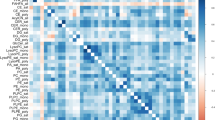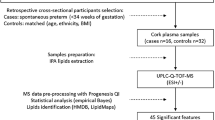Abstract
Background
Docosahexaenoic (C22:6) and arachidonic acid (C20:4) are long-chain polyunsaturated fatty acids (LC-PUFA), essential to fetal development, and preferentially transported by plasma phospholipids.
Objective
To characterize fetal and maternal plasma phospholipid changes during gestation, and to investigate whether LC-PUFA phospholipid profiles are associated with bronchopulmonary dysplasia (BPD).
Design
Cord plasma and parturient serum from N = 108 pregnancies [24–42 week postmenstrual age (PMA)] were collected. Phosphatidylcholine (PC) and phosphatidylethanolamine (PE) were analyzed with tandem mass spectrometry. PMA-associated changes were quantified, and break point analyses served to describe nonlinear changes during gestation.
Results
PC and PE were lower in cord than in parturient samples. In parturients, PC decreased until 33 week PMA, but then re-increased, whereas in cord plasma, concentrations linearly decreased. Fetal PC and PC sub-group values correlated with maternal values. C20:4-PC was twofold higher in cord than in maternal samples throughout gestation. C22:6-PC values, however, exceeded maternal values only beyond 33 week PMA. Consequently, early preterm C20:4-PC-to-C22:6-PC ratio largely exceeded term infant values. In infants born before 28 week PMA, a low C20:4-PC-to-C22:6-PC ratio was associated with BPD severity.
Conclusions
Fetal plasma LC-PUFA–PC composition correlates with maternal values. Fetal C20:4-PC exceeds maternal values throughout gestation, whereas C22:6-PC exceeds maternal values only beyond 33 week PMA, resulting in a low fetal C20:4-PC/C22:6-PC ratio only toward end gestation. A low C20:4-PC/C22:6-PC ratio before 28 week PMA is associated with BPD severity. These data point to a concept of PMA-adjusted ARA and DHA supplementation and, potentially, cord plasma phospholipid analysis for BPD prediction.





Similar content being viewed by others
Abbreviations
- C18:1:
-
Oleic acid
- C18:2:
-
Linoleic acid
- C18:3:
-
Alpha-linoleic acid
- C20:4:
-
Arachidonic acid
- C20:5:
-
Eicosapentaenoic acid
- C22:4:
-
Docosatetraenoic acid
- C22:6:
-
Docosahexaenoic acid
- EDTA:
-
Ethylene diamine tetraacetate
- H-ESI:
-
Heated electrospray ionization interface
- HPLC:
-
High-performance liquid chromatography
- LC–ESI–MS/MS:
-
Liquid chromatography–electrospray ionization interface tandem mass spectrometry
- LC-PUFA:
-
Long-chain polyunsaturated fatty acid
- LDL:
-
Low-density lipoproteins
- PC:
-
Phosphatidylcholine
- PE:
-
Phosphatidylethanolamine
- PEMT:
-
PE-N-methyltransferase
- PMA:
-
Postmenstrual age
- SRM:
-
Specific reaction monitoring
- TIC:
-
Total ion count
- VLDL:
-
Very low-density lipoproteins
- w:
-
Week
References
Le HD, Meisel JA, de Meijer VE, Gura KM, Puder M (2009) The essentiality of arachidonic acid and docosahexaenoic acid. Prostaglandins Leukot Essent Fatty Acids 81:165–170
Sastry PS (1985) Lipids of nervous tissue: composition and metabolism. Prog Lipid Res 24:69–176
Larqué E, Demmelmair H, Berger B, Hasbargen U, Koletzko B (2003) In vivo investigation of the placental transfer of (13)C-labeled fatty acids in humans. J Lipid Res 44:49–55
Escolano-Margarit MV, Ramos R, Beyer J, Csábi G, Parrilla-Roure M, Cruz F, Perez-Garcia M, Hadders-Algra M, Gil A, Decsi T, Koletzko BV, Campoy C (2011) Prenatal DHA status and neurological outcome in children at age 5.5 years are positively associated. J Nutr 141:1216–1223
Ji RR, Xu ZZ, Strichartz G, Serhan CN (2011) Emerging roles of resolvins in the resolution of inflammation and pain. Trends Neurosci 34:599–609
Haggarty P (2010) Fatty acid supply to the human fetus. Annu Rev Nutr 30:237–255
Madsen EM, Lindegaard ML, Andersen CB, Damm P, Nielsen LB (2004) Human placenta secretes apolipoprotein B-100-containing lipoproteins. J Biol Chem 279:55271–55276
Gautier T, Becker S, Drouineaud V, Ménétrier F, Sagot P, Nofer JR, von Otte S, Lagrost L, Masson D, Tietge UJ (2010) Human luteinized granulosa cells secrete apoB100-containing lipoproteins. J Lipid Res 51:2245–2252
Skipski VP (1972) Plasma lipoproteins: composition, structure and biochemistry. In: Nelson GJ (ed) Blood lipids and lipoproteins. Quantitation, composition and metabolism. Wiley-Interscience, New York, pp 471–483
Pynn CJ, Henderson NG, Clark H, Koster G, Bernhard W, Postle AD (2011) Specificity and rate of human and mouse liver and plasma phosphatidylcholine synthesis analyzed in vivo. J Lipid Res 52:399–407
Bernhard W, Raith M, Koch V, Kunze R, Maas C, Abele H, Poets CF, Franz AR (2014) Plasma phospholipids indicate impaired fatty acid homeostasis in preterm infants. Eur J Nutr 53:1533–1547
Grothe J, Riethmüller J, Tschürtz S, Raith M, Pynn CJ, Stoll D, Bernhard W (2015) Plasma phosphatidylcholine alterations in cystic fibrosis patients: impaired metabolism and correlation with lung function and inflammation. Cell Physiol Biochem 35:1437–1453
Raith M, Schaal K, Koslowski R, Fehrenbach H, Poets CF, Schleicher E, Bernhard W (2012) Effects of recombinant human keratinocyte growth factor on surfactant, plasma, and liver phospholipid homeostasis in hyperoxic neonatal rats. J Appl Physiol 112:1317–1328
Voigt M, Fusch C, Olbertz D, Hartmann K, Rochow N, Renken C, Schneider KTM (2006) Analysis of the neonatal collective in the federal republic of germany 12th report: presentation of detailed percentiles for the body measurement of newborns. Geburtsh Frauenheilk 66:956–970
Widdowson EM, Spray CM (1950) Chemical development in utero. Arch Dis Child 26:205–214
Ziegler EE, O’Donnell AM, Nelson SE, Fomon SJ (1976) Body composition of the reference fetus. Growth 40:329–341
Crawford MA (2000) Placental delivery of arachidonic and docosahexaenoic acids: implications for the lipid nutrition of preterm infants. Am J Clin Nutr 71(suppl):275S–284S
Von Houwelingen AC, Badart-Smook A, Hornstra G (1995) Some aspects of neonatal essential fatty acid status are altered by linoleic acid supplementation of women during pregnancy. J Nutr 125:2822–2830
Jobe AH, Bancalari E (2001) Bronchopulmonary dysplasia. Am J Respir Crit Care Med 163:1723–1729
Bligh EG, Dyer WJ (1959) A rapid method of total lipid extraction and purification. Can J Biochem Physiol 37:911–917
Ryan SE, Porth LS (2007) A tutorial on the piecewise regression approach applied to bedload transport data. Gen. Tech. Rep. RMRS-GTR-189. Fort Collins, CO: U.S. Department of Agriculture, Forest Service, Rocky Mountain Research Station. http://www.fs.fed.us/rm/pubs/rmrs_gtr189.pdf
Henriksen C, Haugholt K, Lindgren M, Aurvåg AK, Rønnestad A, Grønn M, Solberg R, Moen A, Nakstad B, Berge RK, Smith L, Iversen PO, Drevon CA (2008) Improved cognitive development among preterm infants attributable to early supplementation of human milk with docosahexaenoic acid and arachidonic acid. Pediatrics 121:1137–1145
Ryan VH, Primiani CT, Rao JS, Ahn K, Rapoport SI, Blanchard H (2014) Coordination of gene expression of arachidonic and docosahexaenoic acid cascade enzymes during human brain development and aging. PLoS One 9(6):e100858. doi:10.1371/journal.pone.0100858
Burdge GC, Kelly FJ, Postle AD (1993) Mechanisms of hepatic phosphatidylcholine synthesis in the developing guinea pig: contributions of acyl remodelling and of N-methylation of phosphatidylethanolamine. Biochem J 290:67–73
Tu WC, Cook-Johnson RJ, James MJ, Mühlhäusler BS, Gibson RA (2010) Omega-3 long chain fatty acid synthesis is regulated more by substrate levels than gene expression. Prostaglandins Leukot Essent Fatty Acids 83:61–68
Luxwolda MF, Kuipers RS, Sango WS, Kwesigabo G, Dijck-Brouwer DA, Muskiet FA (2012) A maternal erythrocyte DHA content of approximately 6 g % is the DHA status at which intrauterine DHA biomagnifications turns into bioattenuation and postnatal infant DHA equilibrium is reached. Eur J Nutr 51:665–675
Decsi T, Fekete M, Szász M, Burus I (1993) Lipid and apolipoprotein levels and enteral nutrition in very low-birth-weight preterm infants. Acta Paediatr 82:663–665
Sovic A, Panzenboeck U, Wintersperger A, Kratzer I, Hammer A, Levak-Frank S, Frank S, Rader DJ, Malle E, Sattler W (2005) Regulated expression of endothelial lipase by porcine brain capillary endothelial cells constituting the blood–brain barrier. J Neurochem 94:109–119
Chen S, Subbaiah PV (2013) Regioisomers of phosphatidylcholine containing DHA and their potential to deliver DHA to the brain: role of phospholipase specificities. Lipids. doi:10.1007/s11745-013-3791-5
Engelmann B, Wiedmann MK (2010) Cellular phospholipid uptake: flexible paths to coregulate the functions of intracellular lipids. Biochim Biophys Acta 1801:609–616
Zeisel SH (2013) Nutrition in pregnancy: the argument for including a source of choline. Int J Womens Health 5:193–199
Makrides M, Neumann MA, Byard RW, Simmer K, Gibson RA (1994) Fatty acid composition of brain, retina and erythrocytes in breast- and formula fed infants. Am J Clin Nutr 60:189–194
Wijendran V, Lawrence P, Diau GY, Boehm G, Nathanielsz PW, Brenna JT (2002) Significant utilization of dietary arachidonic acid is for brain adrenic acid in baboon neonates. J Lipid 43:762–767
Makrides M, Gibson RA, McPhee AJ, Collins CT, Davis PG, Doyle LW, Simmer K, Colditz PB, Morris S, Smithers LG, Willson K, Ryan P (2009) Neurodevelopmental outcomes of preterm infants fed high-dose docosahexaenoic acid: a randomized controlled trial. JAMA 301:175–182
Drover JR, Hoffman DR, Castañeda YS, Morale SE, Garfield S, Wheaton DH, Birch EE (2011) Cognitive function in 18-month-old term infants of the DIAMOND study: a randomized, controlled clinical trial with multiple dietary levels of docosahexaenoic acid. Early Hum Dev 87:223–230
van de Lagemaat M, Rotteveel J, Muskiet FA, Schaafsma A, Lafeber HN (2011) Post term dietary-induced changes in DHA and AA status relate to gains in weight, length, and head circumference in preterm infants. Prostaglandins Leukot Essent Fatty Acids 85:311–316
Fang PC, Kuo HK, Huang CB, Ko TY, Chen CC, Chung MY (2005) The effect of supplementation of docosahexaenoic acid and arachidonic acid on visual acuity and neurodevelopment in larger preterm infants. Chang Gung Med J 28:708–715
Carlson SE, Colombo J, Gajewski BJ, Gustafson KM, Mundy D, Yeast J, Georgieff MK, Markley LA, Kerling EH, Shaddy DJ (2013) DHA supplementation and pregnancy outcomes. Am J Clin Nutr 97:808–815
Carlson SE, Werkman SH, Tolley EA (1996) Effect of long-chain n-3 fatty acid supplementation on visual acuity and growth of preterm infants with and without bronchopulmonary dysplasia. Am J Clin Nutr 63:687–697
Del Prado M, Villalpando S, Elizondo A, Rodríguez M, Demmelmair H, Koletzko B (2001) Contribution of dietary and newly formed arachidonic acid to human milk lipids in women eating a low-fat diet. Am J Clin Nutr 74:242–247
Gibson RA, Muhlhausler B, Makrides M (2011) Conversion of linoleic acid and alpha-linolenic acid to long-chain polyunsaturated fatty acids (LCPUFAs), with a focus on pregnancy, lactation and the first 2 years of life. Matern Child Nutr 7(Suppl 2):17–26
Bernhard W, Full A, Arand J, Maas C, Poets CF, Franz AR (2013) Choline supply of preterm infants: assessment of dietary intake and pathophysiological considerations. Eur J Nutr 52:1269–1278
Bernhard W, Raith M, Kunze R, Koch V, Heni M, Maas C, Abele H, Poets CF, Franz AR (2014) Choline concentrations are lower in postnatal plasma of preterm infants than in cord plasma. Eur J Nutr. doi:10.1007/s00394-014-0751-7
Sosenko IR, Innis SM, Frank L (1988) Polyunsaturated fatty acids and protection of newborn rats from oxygen toxicity. J Pediatr 112:630–637
Sosenko IR, Innis SM, Frank L (1989) Menhaden fish oil, n-3 polyunsaturated fatty acids, and protection of newborn rats from oxygen toxicity. Pediatr Res 25:399–404
Sosenko IR, Innis SM, Frank L (1991) Intralipid increases lung polyunsaturated fatty acids and protects newborn rats from oxygen toxicity. Pediatr Res 30:413–417
Rüdiger M, von Baehr A, Haupt R, Wauer RR, Rüstow B (2000) Preterm infants with high polyunsaturated fatty acid and plasmalogen content in tracheal aspirates develop bronchopulmonary dysplasia less often. Crit Care Med 28:1572–1577
Acknowledgments
This study was supported by an institutional grant (Project No. E.1100008) of the ZEM—Zentrum Ernährungsmedizin of the Medical Faculty of the University of Tuebingen and the University of Hohenheim.
Author information
Authors and Affiliations
Corresponding author
Ethics declarations
Conflict of interest
The authors have no conflicts of interest to disclose.
Financial disclosure
The authors have no financial relationships relevant to this article to disclose.
Electronic supplementary material
Below is the link to the electronic supplementary material.
Rights and permissions
About this article
Cite this article
Bernhard, W., Raith, M., Koch, V. et al. Developmental changes in polyunsaturated fetal plasma phospholipids and feto-maternal plasma phospholipid ratios and their association with bronchopulmonary dysplasia. Eur J Nutr 55, 2265–2274 (2016). https://doi.org/10.1007/s00394-015-1036-5
Received:
Accepted:
Published:
Issue Date:
DOI: https://doi.org/10.1007/s00394-015-1036-5




